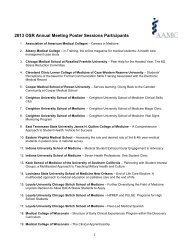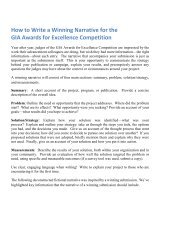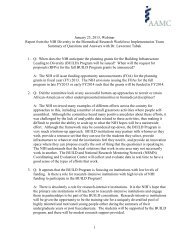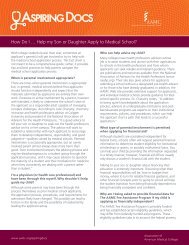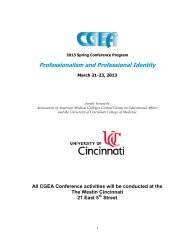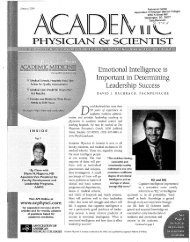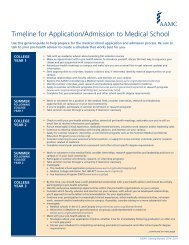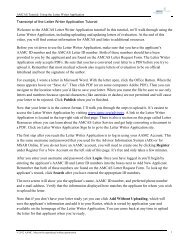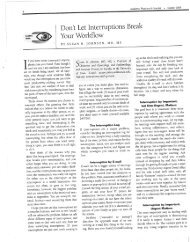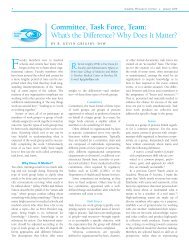The GIA Awards for Excellence recognize outstanding work - AAMC
The GIA Awards for Excellence recognize outstanding work - AAMC
The GIA Awards for Excellence recognize outstanding work - AAMC
You also want an ePaper? Increase the reach of your titles
YUMPU automatically turns print PDFs into web optimized ePapers that Google loves.
GROUP ON INSTITUTIONAL ADVANCEMENT<br />
<strong>The</strong> <strong>GIA</strong> <strong>Awards</strong> <strong>for</strong> <strong>Excellence</strong> <strong>recognize</strong> <strong>outstanding</strong> <strong>work</strong> by members of the <strong>GIA</strong> and<br />
their staffs. <strong>The</strong> awards acknowledge the most creative and effective approaches used<br />
to promote academic medicine through alumni relations, development, marketing,<br />
public affairs, and public relations programs and projects.<br />
Association of American Medical Colleges 2012<br />
It was an honor and privilege to serve as chair of this year’s <strong>GIA</strong> <strong>Awards</strong> <strong>for</strong><br />
<strong>Excellence</strong> competition. This winter, assisted by <strong>AAMC</strong> staff and talented<br />
<strong>GIA</strong> colleagues who served as judges, I had the opportunity to experience<br />
the best of the best of your <strong>work</strong>. We were all impressed by the caliber of<br />
professionalism, creativity, and innovation exhibited by the <strong>GIA</strong> members<br />
who entered the competition. <strong>The</strong>ir achievements in publications, writing,<br />
media relations, special projects, events and online media demonstrated<br />
the powerful impact of institutional advancement at medical schools and<br />
teaching hospitals throughout the United States and Canada.<br />
<strong>The</strong>re were 123 entries from 50 institutions in the competition this year. I<br />
extend my sincere appreciation to all of the judges who generously gave<br />
of their time and expertise. <strong>The</strong>ir dedication to this program was apparent in the careful review and<br />
evaluation of each and every submission.<br />
In addition to the judges, I would also like to acknowledge Tanya Marvin from the City of Hope who<br />
assisted us throughout the entire awards process, along with the <strong>AAMC</strong> staff.<br />
This year, on the 50th anniversary of the <strong>GIA</strong>, we celebrate and honor our colleagues with 15 <strong>Awards</strong> <strong>for</strong><br />
<strong>Excellence</strong> and 18 Honorable Mentions. <strong>The</strong> judges selected award recipients who are truly going above<br />
and beyond to produce exemplary <strong>work</strong> and achieve standout results. <strong>The</strong> award-winning submissions<br />
remind all of us why we are involved in the important <strong>work</strong> of advancing the missions of medical<br />
education, research, and patient care. I hope you will take the time to view and learn more about these<br />
entries.<br />
Congratulations to the Award <strong>for</strong> <strong>Excellence</strong> honorees and to all who entered and participated in the<br />
competition. And thanks again to all of the individuals who made this year’s competition a success. We<br />
can all take pride in celebrating the <strong>outstanding</strong> <strong>work</strong> of our colleagues in <strong>GIA</strong>.<br />
Sincerely,<br />
Brenda Maceo<br />
<strong>GIA</strong> <strong>Awards</strong> Chair and Vice Chair <strong>for</strong> Marketing, Public Affairs and Public Relations<br />
Vice President, Public Relations and Marketing<br />
University of Southern Cali<strong>for</strong>nia<br />
41
42<br />
2012 <strong>GIA</strong> <strong>Awards</strong> <strong>for</strong> <strong>Excellence</strong> Judges<br />
GROUP ON INSTITUTIONAL ADVANCEMENT<br />
Publications Category; Shoestring Category; Special Projects, Programs, Campaigns Category;<br />
and Premier Per<strong>for</strong>mance Category Judges<br />
David Anderson, Medical Foundation of North Carolina and University of North Carolina at Chapel Hill<br />
School of Medicine<br />
Edward Keohane, University of Massachusetts Medical School<br />
Michael Knecht, Robert Wood Johnson University Hospital<br />
Jacqueline Kozloski, Thomas Jefferson University and Hospital<br />
Electronic Communications Category Judges<br />
Cynthia Floyd Manley, Vanderbilt University Medical Center<br />
Jacob Portnoy, University of Minnesota Academic Health Center<br />
Vincent Rhodes, Eastern Virginia Medical School<br />
Robert G. Fenley Writing Category Judges<br />
Heidi Cannella, UT Southwestern Medical Center<br />
Richard Puff, University of Cincinnati College of Medicine<br />
Jonathan Rabinovitz, Stan<strong>for</strong>d University School of Medicine<br />
2012 <strong>GIA</strong> <strong>Awards</strong> <strong>for</strong> <strong>Excellence</strong> Chair<br />
Brenda Maceo<br />
Vice President, Public Relations and Marketing<br />
University of Southern Cali<strong>for</strong>nia<br />
<strong>The</strong> <strong>GIA</strong> extends its gratitude to Brenda and her colleague at City of Hope, Tanya Marvin <strong>for</strong> overseeing<br />
and administering the awards competition, and to each of the judges <strong>for</strong> volunteering their time and<br />
expertise. Many thanks to all who submitted entries.<br />
Association of American Medical Colleges 2012
GROUP ON INSTITUTIONAL ADVANCEMENT<br />
<strong>GIA</strong> Award <strong>for</strong> <strong>Excellence</strong><br />
Publications Category: Single or Special Issue<br />
From left: Minnie Glymph, Director of Marketing<br />
Communications; Jennifer Sweeting, Designer;<br />
Kevin Kearns, Design Director; Carol Harbers,<br />
Senior Editor; Jill Boy, Director of Marketing and<br />
Communications, Duke Cancer Institute. Not<br />
pictured: William Blackburn, Production Manager.<br />
Association of American Medical Colleges 2012<br />
Duke Cancer Report<br />
Duke Medicine<br />
Duke Cancer Report is a publication intended to support the Duke brand<br />
and raise awareness locally and globally of Duke Medicine’s mission of<br />
trans<strong>for</strong>ming medicine and health.<br />
<strong>The</strong> challenge:<br />
Duke Cancer Report’s primary objective is to raise awareness about Duke’s<br />
leadership in cancer research and patient care. Part of the challenge included<br />
how most effectively and economically to communicate that message to the<br />
center’s key audiences, including referring physicians, oncology specialists,<br />
and national oncology leaders.<br />
<strong>The</strong> solution:<br />
Although the report is an in-depth, weighty communication, the in<strong>for</strong>mation<br />
is delivered with concisely written copy and a lot of illustration, including<br />
graphs, callouts, bulleted lists, photographs, captions, and subheads. Its <strong>for</strong>mat was designed to be scanned, encouraging<br />
readers to jump to in<strong>for</strong>mation on a specific topic or quickly get a general sense of the progress of Duke’s cancer research<br />
and patient care initiatives. To increase the report’s value <strong>for</strong><br />
future reference, contact in<strong>for</strong>mation was included <strong>for</strong> clinical<br />
trials; research sources were listed within the articles; and contact<br />
in<strong>for</strong>mation <strong>for</strong> specific researchers and physicians was included.<br />
“Resources <strong>for</strong> Clinicians” was placed on the back cover <strong>for</strong> ease<br />
of use.<br />
To save money, the report also served as a fundraising<br />
publication. <strong>The</strong> development staff opted not to produce an<br />
annual report and instead mailed this report to donors.<br />
<strong>The</strong> results:<br />
A national reader survey of referring physicians in January 2011<br />
found:<br />
76 percent had read the report; 41 percent felt more positive<br />
about Duke cancer research and care after reading the report;<br />
and 8 percent were prompted to take action (go online <strong>for</strong> more<br />
in<strong>for</strong>mation; contact a specialist).<br />
In November 2010, Duke distributed 63,000 copies of the report in advance of the U.S. News survey period <strong>for</strong> selecting<br />
the top medical centers in the nation. Duke’s reputation score in cancer rose nationally by more than 2 points over its<br />
2010 score, and the center moved from 12th position to 11th position.<br />
Judges said: “One of the most clear, crisp and efficient uses of data I have seen in a publication.”<br />
Contact: Carol Harbers, carol.harbers@duke.edu<br />
43
<strong>GIA</strong> Award <strong>for</strong> <strong>Excellence</strong><br />
Publications Category: External Audience Periodicals<br />
From left: Laura Grunberger, Senior Editor; Amanda<br />
Busick, Editorial Assistant; Kenneth Ross, Director,<br />
Development Communications; Louise Cobb,<br />
Editorial Coordinator.<br />
44<br />
Discoveries Magazine<br />
Cedars-Sinai Medical Center<br />
GROUP ON INSTITUTIONAL ADVANCEMENT<br />
Discoveries magazine is Cedars-Sinai Medical Center’s flagship publication about<br />
medical research and its impact on patient care. Through engaging humaninterest<br />
and trend stories, Discoveries showcases the excitement of scientific<br />
discovery and the men and women who benefit from it. <strong>The</strong> twice-yearly<br />
magazine is mailed free to approximately 150,000 subscribers in Southern<br />
Cali<strong>for</strong>nia, including patients, donors, faculty, staff, media, and friends.<br />
<strong>The</strong> challenge:<br />
Cedars-Sinai, the largest nonprofit hospital in the western United States, also<br />
maintains one of the top non-university–based medical research programs<br />
in America—but that fact is largely unknown. <strong>The</strong> purpose of Discoveries<br />
magazine is to raise awareness about this lifesaving research and the role<br />
it plays in advancing clinical care without diluting or oversimplifying the<br />
message <strong>for</strong> a sophisticated lay audience.<br />
<strong>The</strong> solution:<br />
Cedars-Sinai created a sophisticated, friendly, and fresh design <strong>for</strong> the<br />
magazine that allows lay readers to connect with complex scientific topics in<br />
an exciting visual way. Because the majority of research under way at Cedars-<br />
Sinai is translational, the medical center has an extraordinary resource <strong>for</strong><br />
stories: its patients.<br />
By focusing on storytelling, the editorial team creates a personal and<br />
emotional connection between the reader and the topic. Many feature articles tell the stories of patients who have<br />
directly benefitted from new technology or clinical trials. Others involve nontraditional storytelling approaches such as<br />
infographics and photo essays to convey their message.<br />
<strong>The</strong> results:<br />
Cedars-Sinai Discoveries has been well received. Circulation has grown from 40,000 to 150,000 in five years. It is also<br />
distributed in the hospital public areas, in waiting rooms, and in doctors’ offices, and sent to partner institutions around<br />
the country. Survey results indicate that it is one of the hospital’s most effective communication vehicles <strong>for</strong> reaching out<br />
to donors and patients alike.<br />
<strong>The</strong> summer 2011 issue, which featured a story about a new valve replacement surgery in clinical trials, was used by a<br />
major heart valve manufacturer to present its product to other medical institutions. <strong>The</strong> same story led to several referrals<br />
of patients who eventually took part in the clinical trial described in the story.<br />
Judges said: “An incredibly sharp publication that is equal parts modern, interactive and inspiring.”<br />
Contact: Laura Grunberger, grunbergerl@cshs.org<br />
Association of American Medical Colleges 2012
GROUP ON INSTITUTIONAL ADVANCEMENT<br />
<strong>GIA</strong> Award <strong>for</strong> <strong>Excellence</strong><br />
Publications Category: Internal Audience Periodicals<br />
From left: Mary Lynn Carver, SVP, Communications<br />
and Public Affairs; Linda Praley, Creative Director;<br />
Frank Moorman, Director of Strategic Internal<br />
Communications; Anne Haddad, Publications<br />
Manager/Editor.<br />
Association of American Medical Colleges 2012<br />
Launching a New Brand: UMMC Connections<br />
University of Maryland Medical Center<br />
UMMC Connections, an internal quarterly publication, showcases the<br />
people and programs that inspire pride across the University of Maryland<br />
Medical Center. In the spring of 2011, UMMC Connections was redesigned<br />
to promote the partnership of the hospital and its affiliate—the University<br />
of Maryland. As part of that restructuring, UMMC Connections transitioned<br />
from bimonthly to quarterly.<br />
<strong>The</strong> challenge:<br />
As part of the rebranding, UMMC Connections was redesigned to fulfill two<br />
goals: to promote the interprofessional connections between the university<br />
and the hospital, and to produce content appealing to patients and visitors,<br />
in addition to the 6,800 hospital employees and 1,200 attending physicians.<br />
With its broader outreach and the transition from bimonthly to quarterly, the<br />
editorial team had to be more selective in the stories they chose and more<br />
creative in the way those stories were told.<br />
<strong>The</strong> solution:<br />
<strong>The</strong> rebranding debuted May 12, 2011. A new logo and color palette meant<br />
a whole new design <strong>for</strong> the publication, whose spring issue was distributed<br />
immediately after the public unveiling of the logo. <strong>The</strong> new design presented<br />
all articles in a bolder and fresher way. New taglines and features, such as a<br />
spring-themed back page, rein<strong>for</strong>ced the quarterly publication schedule.<br />
Because this issue was published during National Nurses Week, the team<br />
demonstrated the interprofessional collaboration of the university-hospital<br />
partnership through the context of nursing. Past Connections issues featured<br />
stand-alone patient stories. Due to space constraints, patient stories<br />
became part of larger stories that promoted other hospital initiatives and<br />
accomplishments.<br />
<strong>The</strong> result:<br />
<strong>The</strong> redesign was well-received by staff members, with more hits on the Web and depletion of the print issues at many of<br />
the 22 distribution kiosks. <strong>The</strong> biggest difference was an increase of about 500 more hits to the electronic version from<br />
the Internet, indicating it appealed beyond the usual internal audience. Moreover, the 8,300 copies of the spring 2011<br />
issue placed in kiosks around the hospital were depleted at a faster rate than in the past, especially at the main entrances<br />
where patients and visitors enter the hospital.<br />
Judges said: “This is what an internal piece should look like.”<br />
Contact: Meghan Scalea, mscalea@umm.edu<br />
45
<strong>GIA</strong> Award <strong>for</strong> <strong>Excellence</strong><br />
Electronic Communications Category: Non-Web-based<br />
David A. Feinberg, Vice President of Marketing and<br />
Chief Marketing Officer<br />
46<br />
Amazing Things Are Happening Here<br />
New York-Presbyterian Hospital<br />
GROUP ON INSTITUTIONAL ADVANCEMENT<br />
In an ef<strong>for</strong>t to regain recognition of its stature in the face of increasing<br />
competition, New York-Presbyterian (NYP) Hospital created an advertising<br />
campaign to differentiate itself from its competitors. Inspiration came from<br />
hospital-conducted interviews with patients who consistently expressed their<br />
positive experiences, passionately and emotionally, with the staff at NYP.<br />
<strong>The</strong>se interviews evolved into the “Amazing Things Are Happening Here”<br />
campaign.<br />
<strong>The</strong> challenge:<br />
In 2010, the New York marketplace had become cluttered with advertising<br />
from three local NYP competitors. <strong>The</strong>ir messages attempted to copy NYP’s<br />
leadership positioning and they outspent NYP by at least 2<br />
to 1 in media. Results of independent research companies<br />
indicated that competitors’ advertising was generating<br />
greater audience awareness than NYP’s advertising ef<strong>for</strong>ts.<br />
<strong>The</strong> solution:<br />
NYP decided to capture its patients’ incredible medical<br />
journeys on camera, unscripted, in a unique testimonial<br />
<strong>for</strong>mat to reignite consumer awareness of the brand.<br />
Using black-and-white video, the hospital’s advertising<br />
agency produced simple, authentic, 60-second visuals<br />
of five patients sharing their experiences at NYP be<strong>for</strong>e,<br />
during, and after treatment. To rein<strong>for</strong>ce the advertising<br />
message, the agency undertook an integrated campaign<br />
of television, billboard, and online exposure.<br />
<strong>The</strong> result:<br />
According to independent research indicators, “unaided advertising awareness” more than doubled, from 11 to 24<br />
percent, after only four weeks on air, surpassing all competition. It sustained this level after three months on air. “Positive<br />
word-of-mouth/buzz” increased from 17 to 26 percent. NYP ads significantly outscored the competition and attained<br />
benchmark goals of greater than 50 percent response <strong>for</strong> several key attributes, including “differentiation,” “relevancy,”<br />
and “in<strong>for</strong>mation worth sharing.” Almost half of respondents gave NYP commercials an “excellent” rating—double<br />
that of the leading competitor. According to internal NYP data, telephone inquiries from referring physicians increased<br />
approximately 25 percent, and unique daily visits to the Web site increased more than 40 percent.<br />
Judges said: “Kudos to the marketing team <strong>for</strong> finding those stories and more importantly <strong>for</strong> having the sense to get<br />
out of the way and let the patients tell them.”<br />
Contact: David Feinberg, daf@nyp.org<br />
Association of American Medical Colleges 2012
GROUP ON INSTITUTIONAL ADVANCEMENT<br />
<strong>GIA</strong> Award <strong>for</strong> <strong>Excellence</strong><br />
Electronic Communications Category: Web-based<br />
Scope medical blog team<br />
Association of American Medical Colleges 2012<br />
Scope Medical Blog<br />
Stan<strong>for</strong>d University School of Medicine<br />
Scope (http://scopeblog.stan<strong>for</strong>d.edu) is a group-authored medical blog<br />
offering external audiences a curated source of biomedical news and<br />
conversation.<br />
<strong>The</strong> challenge:<br />
Historically, the Office of Communication and Public Affairs at Stan<strong>for</strong>d<br />
University School of Medicine has promoted the research and clinical<br />
enterprise of its faculty through print and broadcast media. Over the past<br />
four years, however, social media has disrupted the<br />
traditional newsroom and simultaneously offered an<br />
opportunity <strong>for</strong> the school of medicine to connect directly<br />
with its audiences.<br />
<strong>The</strong> solution:<br />
Scope was launched as a medical blog to provide external<br />
audiences with access to high-quality, timely biomedical<br />
news and conversation. It is designed to reach two<br />
primary audiences: health care and biomedical research<br />
professionals; and educated, science-minded U.S. adults.<br />
To be credible, the blog would need high-quality writing and<br />
processes that could support high-volume output delivered in<br />
a style true to the medium. All writers on Scope are asked to<br />
leverage their expertise (many have Ph.D.’s or other graduate<br />
education in the life sciences) and follow their interests.<br />
Two contributors also act as editors. A style frame<strong>work</strong> was<br />
developed to create a consistent experience <strong>for</strong> readers that<br />
is elegant and noise-free and also offers a variety of syndication options such as a Twitter feed and an RSS feed. <strong>The</strong> School of<br />
Medicine brand is present but does not dominate the design. Stan<strong>for</strong>d’s In<strong>for</strong>mation Resources & Technology (IRT) department<br />
has managed two site builds. Scope runs on a custom WordPress installation that IRT also maintains.<br />
<strong>The</strong> results:<br />
In its few first months of publication, Scope site visits averaged in the thousands. In 2011, however, the blog averaged<br />
about 25,000 unique visitors per month, with a peak of 42,000 visitors in its busiest month. About 49 percent of traffic<br />
comes from referrals from other sites (excluding search engines), indicating heavy linking to Scope.<br />
Scope entries have been referenced in, or included on, Boing Boing, Medgadget, New York Times’s Motherlode, Los<br />
Angeles Times’s Booster Shots, KevinMD.com, 33 Charts, and countless other sites.<br />
Judges said: “Scope Medical Blog succeeds where many of us have tried and failed.”<br />
Contact: John Staf<strong>for</strong>d, john.staf<strong>for</strong>d@stan<strong>for</strong>d.edu<br />
47
<strong>GIA</strong> Award <strong>for</strong> <strong>Excellence</strong><br />
<strong>The</strong> Robert G. Fenley Writing Category: Basic Science Staff Writing<br />
Elaine Vitone, Associate Editor, Pitt Med Magazine<br />
48<br />
“Mars and Venus, Revisited”<br />
By Elaine Vitone<br />
Pitt Med Magazine<br />
University of Pittsburgh School of Medicine<br />
GROUP ON INSTITUTIONAL ADVANCEMENT<br />
For decades, epidemiological studies have shown sex-based differences in<br />
a number of diseases and disorders—but amazingly, scientists have only<br />
recently begun to analyze data by sex or even to consider it as a variable. <strong>The</strong><br />
author started asking Pitt researchers what they were learning and found<br />
that men and women and boys and girls are worlds apart in terms of their<br />
nervous, cardiovascular, musculoskeletal, and immune systems, and that<br />
these differences have important health implications.<br />
An excerpt:<br />
To say that men and women are of different minds is a tired punch<br />
line, a fact of life we accept so fully that it’s practically old hat. But<br />
if you try to talk about differences in terms of the structure and<br />
function of the brain—the organ itself—scientists stumble over the<br />
idea, hindered by certain hang-ups.<br />
For one, throughout the history of our evolving understanding<br />
of human health, we’ve tended to chalk up every inconsistency<br />
between the sexes as a function of the circulating hormones that<br />
are so powerful through our reproductive years. For another, if<br />
you point out a difference—even something as statistically strong<br />
as the slant toward women when it comes to major depression—<br />
people shrug it off. … People tend to get caught up in the social<br />
construct of gender if you try to talk about the sexes in terms of<br />
biology.<br />
But in recent years, scientific circles have begun to accept the<br />
notion that socialization isn’t all to blame. If it were, why would<br />
women in Sweden—a place where education and labor laws<br />
have gone a long way to foster equality among men and women—be just as prone to depression as American women?<br />
Nor can we explain it all away with circulating hormones. For example, Alzheimer’s disease—which emerges years after<br />
sex hormone levels wane—is more fatal in men than in women. Investigators at Pitt and elsewhere are finding that we<br />
are built differently and wired differently, quite literally. <strong>The</strong> neurocircuitry that connects the parts of the brain has a very<br />
distinct way of evolving in males versus females. It turns out, we are fundamentally different, even at the cellular level.…<br />
Judges said: “This article shows tremendous enterprise in drawing together different strands of research around the<br />
medical school and tying them together in answer to a fascinating question.”<br />
Contact: Margaret McDonald, mmaggie@pitt.edu<br />
Association of American Medical Colleges 2012
GROUP ON INSTITUTIONAL ADVANCEMENT<br />
<strong>GIA</strong> Award <strong>for</strong> <strong>Excellence</strong><br />
<strong>The</strong> Robert G. Fenley Writing Category: General Staff Writing<br />
David Greenwald, Editor, UCLA<br />
Medicine<br />
SUMMEr 2011<br />
uclaMEDICINE<br />
Foreign Exchange<br />
Partnership with Chinese university<br />
opens the door to broader global reach<br />
A New Paradigm<br />
UCLA puts patients front and center<br />
Sisterhood<br />
Female philanthropists support<br />
research in women’s health<br />
Conversation<br />
Dr. Mario C. Deng takes heart<br />
Association of American Medical Colleges 2012<br />
“A Second Hand, a Second Chance”<br />
By David Greenwald<br />
UCLA Medicine<br />
UCLA Health System<br />
In July 2010, UCLA Health System announced it was establishing a hand-transplantation<br />
program. While hand transplants had been per<strong>for</strong>med elsewhere in the country, the UCLA<br />
Hand Transplant Program would be only the fourth in the country and the first such program<br />
in the western United States. This article in UCLA Medicine discusses the new program and<br />
groundbreaking surgical procedure through the prism of its first patient, to open a window<br />
<strong>for</strong> readers on her life and to take them into the operating room to experience the drama of<br />
the surgery and its impact on the life of one patient and her family.<br />
An excerpt:<br />
At 2:55 in the afternoon on March 5, 2011—one of those lovely sun-washed days in<br />
Los Angeles—Emily Fennell moves the index finger of her right hand. This wouldn’t be<br />
remarkable if not <strong>for</strong> the fact that just hours earlier Emily had no right hand at all.<br />
A Second Hand, a Second Chance<br />
Surgeons at UCLA per<strong>for</strong>m first hand transplant in the Western U.S.<br />
Spring11_Cover.FINAL.indd 1 6/9/11 12:36 PM<br />
But now, 16 hours after she was wheeled into O.R. 12 on the second<br />
floor of Ronald Reagan UCLA Medical Center, Emily has a new right<br />
hand of flesh and bone, with five long, slender fingers, and the hope of<br />
recapturing a more normal life. And with that slight, almost imperceptible<br />
stirring of her finger, Emily Fennell, a 26-year-old mother from Yuba City,<br />
Cali<strong>for</strong>nia, becomes a part of history as the first patient in the Western<br />
United States to receive a hand transplant. And UCLA makes history as<br />
the first hospital west of the Rockies to per<strong>for</strong>m the landmark surgery.<br />
… As she is rolled in her bed down the long corridor to the O.R. suites,<br />
Emily’s mother, Kim Herman, who arrived at the hospital shortly after her<br />
daughters, and Andrea follow. <strong>The</strong> procession stops at the red line on<br />
the floor, beyond which family cannot pass. It is the moment <strong>for</strong> Kim and<br />
Andrea to say good-bye. Each leans over to wrap Emily in a long, tight<br />
hug. <strong>The</strong> medical team has assured Emily that even at this stage, she can<br />
still change her mind about the surgery. “Are you sure?” Kim asks very<br />
softly. “Yes,” Emily responds. “I’m sure. I’m scared, but I’m sure.”<br />
Judges said: “Expertly written. <strong>The</strong> writer pulls you through the surgery<br />
giving the reader an excellent eyewitness account.”<br />
Contact: David Greenwald, dgeenwald@mednet.ucla.edu<br />
49
<strong>GIA</strong> Award <strong>for</strong> <strong>Excellence</strong><br />
<strong>The</strong> Robert G. Fenley Writing Category: Solicited Articles<br />
Discoveries staff, from left: Laura Grunberger,<br />
Senior Editor; Amanda Busick, Editorial<br />
Assistant; Kenneth Ross, Director, Development<br />
Communications; Louise Cobb, Editorial<br />
Coordinator.<br />
Aging<br />
with<br />
AIDS<br />
Adults with HIV/AIDS<br />
are living longer<br />
lives, but face<br />
a new challenge.<br />
I<br />
BY KIM KoWSKY<br />
n 1983, Steve Bolan spent his<br />
40th birthday getting a physical.<br />
Although the movie advertising<br />
executive seemed healthy, he was<br />
worried about a mysterious illness<br />
that was making many of his friends<br />
seriously sick.<br />
Steve received a clean bill of health,<br />
except <strong>for</strong> a strange but benign yeast<br />
infection normally seen only in infants.<br />
When the infection persisted <strong>for</strong> a year,<br />
his doctor finally diagnosed him with<br />
AIDS-related complex, or ARC, a term<br />
no longer in use to describe people<br />
who have minor symptoms caused by<br />
infection with Human Immunodeficiency<br />
Virus (HIV).<br />
38 Discoveriesmagazine.org<br />
50<br />
“Aging with AIDS”<br />
By Kim Kowsky<br />
Edited by Laura Grunberger<br />
Discoveries<br />
Cedars-Sinai Medical Center<br />
GROUP ON INSTITUTIONAL ADVANCEMENT<br />
As more people with HIV/AIDS enter middle and older age, a cruel irony is<br />
emerging: the same medications that saved and prolonged their lives also<br />
may be contributing to several serious chronic illnesses and challenging the<br />
prevailing view of AIDS as a manageable condition. Through the story of a<br />
67-year-old patient and interviews with epidemiologists and neuroscientists<br />
at Cedars-Sinai, freelance writer Kim Kowsky and senior editor Laura<br />
Grunberger <strong>work</strong>ed together closely to give the story focus and direction.<br />
<strong>The</strong> editor also suggested a “by the numbers” page to give the story context.<br />
Taking some of the statistics out of the body copy helped the flow of the<br />
story and released its emotional content.<br />
An excerpt:<br />
In 1983, Steve Bolan spent his 40th birthday getting a<br />
physical. Although the movie advertising executive seemed<br />
healthy, he was worried about a mysterious illness that was<br />
making many of his friends seriously sick. Steve received a<br />
clean bill of health, except <strong>for</strong> a strange but benign yeast<br />
infection normally seen only in infants. When the infection<br />
persisted <strong>for</strong> a year, his doctor finally diagnosed him with<br />
AIDS-related complex, or ARC, a term no longer in use<br />
to describe people who have minor symptoms caused by<br />
infection with Human Immunodeficiency Virus (HIV). “I knew<br />
it wasn’t good news, but no one really understood what it<br />
meant,” says Steve, who was eventually diagnosed with fullblown<br />
Acquired Immunodeficiency Syndrome, or AIDS.<br />
“More and more people around me were getting sick and dying, but all my doctor could say was ‘let’s wait and see.’ That<br />
was the horrible part—waiting <strong>for</strong> him to tell me my time was up.” …<br />
Steve, whose diagnosis and treatment have run roughly parallel to the evolution of drugs that fight the disease, now<br />
suffers from diabetes, heart disease, and liver problems that may, in part, be induced by these medications. “My doctor<br />
has been trying to convince me that what I should worry about now is heart disease or diabetes, not AIDS,” says Steve.<br />
Judges said: “A fresh take on an old subject. Great patient story. Great quotes. Well-executed.”<br />
Contact: Laura Grunberger, grunbergerl@cshs.org<br />
steve Bolan (right)—<br />
photographed with his<br />
partner, colin Hadlow,<br />
and their dog nipper—<br />
was diagnosed with aiDs<br />
in the ’80s. now 67, he is<br />
waging a new battle with<br />
the disease and the<br />
medications that have<br />
kept him alive <strong>for</strong> so<br />
many years.<br />
Association of American Medical Colleges 2012
GROUP ON INSTITUTIONAL ADVANCEMENT<br />
<strong>GIA</strong> Award <strong>for</strong> <strong>Excellence</strong><br />
Special Projects, Programs, or Campaigns Category: Alumni Relations<br />
From left: Fred Lee, Associate Director, UBC Alumni<br />
Affairs; Sarah Roth, Assistant Dean, Development<br />
and Alumni, UBC Faculty of Medicine; Anne<br />
Campbell-Stone, Director, Alumni Relations,<br />
UBC Faculty of Medicine; Marisa Moody, Alumni<br />
Relations Officer, UBC Faculty of Medicine; Kira<br />
Peterson, Alumni Relations Coordinator, UBC<br />
Faculty of Medicine.<br />
Association of American Medical Colleges 2012<br />
Celebrating the Life and Legacy of Dr. Peter<br />
University of British Columbia, Faculty of Medicine<br />
Dr. Peter Jepson-Young, a 1985 M.D. graduate of the University of British<br />
Columbia (UBC), dedicated his life to advancing acceptance and treatment of<br />
HIV/AIDS through sharing his own story, which he told on television through<br />
<strong>The</strong> Dr. Peter Diaries, and through the Dr. Peter AIDS Foundation (DPAF), which<br />
he established just weeks be<strong>for</strong>e he died on Nov. 17, 1992. From 1990 to 1992<br />
the Canadian Broadcasting Corporation (CBC) aired 111 weekly episodes of<br />
<strong>The</strong> Diaries, giving many people their first introduction to someone who was<br />
openly gay and had AIDS. Dr. Peter’s life and legacy touched the UBC Faculty<br />
of Medicine’s alumni affairs team, and they wanted to <strong>recognize</strong> their late<br />
classmate at the 25th anniversary of the M.D. Class of 1985.<br />
<strong>The</strong> challenge:<br />
<strong>The</strong> alumni affairs team set dual goals of planning an <strong>outstanding</strong> reunion<br />
and a celebration of Dr. Peter’s life that would raise awareness and<br />
understanding of HIV/AIDS. <strong>The</strong>y needed to collaborate with three other<br />
independent teams, UBC Central Alumni Affairs, the CBC, and the DPAF,<br />
and ensure that the event stayed focused on Dr. Peter’s life and legacy, not<br />
individual projects or messages.<br />
<strong>The</strong> solution:<br />
<strong>The</strong> team chose the CBC studios as their venue. Plans included showing<br />
a consolidated video of <strong>The</strong> Dr. Peter Diaries to be followed by a panel<br />
discussion with some of Dr. Peter’s classmates, his mother, and the Diaries<br />
producer. <strong>The</strong> DPAF provided hors d’oeuvres and volunteers to serve at the<br />
reception. UBC Central Alumni Affairs secured the studio, covered the cost<br />
of technical labor onsite and the RSVP and e-blast system, provided the e-vite<br />
design and printed program, and contributed staff to help organize the<br />
event. <strong>The</strong> CBC discounted the rental cost of the studio and provided a wellknown<br />
CBC personality to moderate the panel. After the many in‐kind contributions, there was no monetary cost to the<br />
event <strong>for</strong> the Faculty of Medicine Alumni Affairs, other than staffing.<br />
<strong>The</strong> results:<br />
Registration was full within 24 hours, and the audience of 315 packed the CBC studios on September 9, 2010. <strong>The</strong><br />
Vancouver Sun and the National Post brought local and national publicity to the event and the HIV/AIDS research<br />
under way at UBC. <strong>The</strong> Class of ’85 raised $24,000 <strong>for</strong> the DPAF, adding to the $1.3 million raised during DPAF’s 20th<br />
anniversary celebrations in the following weeks.<br />
Judges said: “Very compelling approach to engage broad groups in support of a valued alum. While the metrics provided<br />
include dollars raised, they clearly achieved so much more.”<br />
Contact: Marisa Moody, marisa.moody@ubc.ca<br />
51
<strong>GIA</strong> Award <strong>for</strong> <strong>Excellence</strong><br />
Special Projects, Programs, or Campaigns Category: Marketing<br />
Judi Goodfriend, Manager,<br />
Marketing Communications,<br />
UCLA Health System<br />
52<br />
My Hospital Notebook<br />
UCLA Health System<br />
GROUP ON INSTITUTIONAL ADVANCEMENT<br />
Because UCLA is a quaternary academic medical center, many pediatric patients spend<br />
extended periods hospitalized. Recognizing a need <strong>for</strong> a support group, the director of child<br />
life services <strong>for</strong>med the UCLA Parent Advisory Council (PAC). One of PAC’s first actions was<br />
to conceive of a binder that would be rich with advice, resources, and words of wisdom <strong>for</strong><br />
parents of children newly diagnosed with a chronic or life-threatening condition. Marketing<br />
was asked to make the parents’ vision a reality.<br />
<strong>The</strong> challenge:<br />
Marketing’s job was to bring this labor of love to life, honoring the vision and content the<br />
PAC requested while maintaining UCLA’s brand and messaging. <strong>The</strong> goals included creating<br />
materials in a <strong>for</strong>mat that could be easily updated; finding a suitable binder; and creating<br />
English and Spanish versions.<br />
<strong>The</strong> solution:<br />
<strong>The</strong> “My Hospital Notebook” binder incorporates the words of wisdom<br />
from PAC parents and serves as a reference guide. It contains a welcome<br />
letter from the chair of pediatrics and the PAC, and seven sections:<br />
• Who’s taking care of my child?<br />
• What do we need to know about the hospital?<br />
• Where do we stay if our child is in the hospital <strong>for</strong> awhile?<br />
• What do we do if we need a break?<br />
• Where can we find additional support?<br />
• Tips <strong>for</strong> communicating with your medical team<br />
• My in<strong>for</strong>mation organizer<br />
Divider pages feature anecdotal advice from parents and warm,<br />
engaging photography. To rein<strong>for</strong>ce the overall brand, the theme “It<br />
begins with U” was incorporated. <strong>The</strong> binder has pockets and blank<br />
pages and tabs <strong>for</strong> adding personalized in<strong>for</strong>mation. <strong>The</strong> content files are maintained in Microsoft Word, allowing hospital<br />
staff to update in<strong>for</strong>mation easily and inexpensively.<br />
<strong>The</strong> result:<br />
Parents are appreciative and excited to receive the binder—and say it gives them a sense of independence. Outpatient<br />
clinic staff also use the binder to in<strong>for</strong>m parent about services when an outpatient is going to be admitted. Several council<br />
members have used to the binders themselves; one placed her daughter’s medical data inside to keep everything in one<br />
place.<br />
Judges said: “A beautiful and easy-to-use product. I imagine it seemed a bible to some parents during their child’s<br />
hospital stay.”<br />
Contact: Judi Goodfriend, jgoodfriend@mednet.ucla.edu<br />
Association of American Medical Colleges 2012
GROUP ON INSTITUTIONAL ADVANCEMENT<br />
<strong>GIA</strong> Award <strong>for</strong> <strong>Excellence</strong><br />
Special Projects, Programs, or Campaigns Category: Public Affairs/Community Relations<br />
Top row, from left: Raymond Brouillard,<br />
Jim Barrett, Mike Cooper, Mark Navarro.<br />
Middle row, from left: Jim Kelly, Molly<br />
Dannenmaier, Maureen Bayless Balleza,<br />
Kristen Hensley, Mary Ann Hellinghausen.<br />
Bottom row, from left: Christian von<br />
Eschenbach, Raul Reyes, Chris Comer,<br />
Mary Havard, Tonya Allyn-Broussard, Eva<br />
Tillmon. Not pictured: Myra McCollum<br />
and Joanne Salt.<br />
Association of American Medical Colleges 2012<br />
Funding UTMB’s Future: Communications Strategies <strong>for</strong> a Texas-Sized<br />
Challenge<br />
University of Texas Medical Branch<br />
In 2008, the main campus of University of Texas Medical Branch (UTMB) on<br />
Galveston Island sustained more than $1 billion in damage from Hurricane Ike. A<br />
groundswell of community support prevented the closure of campus and UTMB<br />
garnered support from the 2009 Texas Legislature. But <strong>work</strong> toward recovery<br />
remained as the 2011 legislative session drew near and Texas grappled with<br />
balancing its budget.<br />
<strong>The</strong> challenge:<br />
<strong>The</strong> Office of Public Affairs had to achieve the following results in the 2011 legislative<br />
session: debt service on a tuition revenue bond <strong>for</strong> a new hospital; maintain a fund<br />
<strong>for</strong> storm recovery; maintain base funding to preserve Level I trauma center status;<br />
and obtain a new contract <strong>for</strong> correctional-care services.<br />
<strong>The</strong> solution:<br />
Public Affairs developed an in<strong>for</strong>mation campaign to educate key audiences about<br />
the legislative process; implemented a statewide media relations campaign; and<br />
positioned UTMB leaders as experts on numerous issues to be<br />
debated by the Texas Legislature.<br />
Outreach through print materials included one-page briefings<br />
<strong>for</strong> legislative staff; pocket cards providing at-a-glance access to<br />
data on economic impact and legislative priorities; presentations<br />
to legislative committees; and letters from the UTMB president to<br />
donors and alumni. Web-based outreach included Ben’s Blog, a<br />
view of the session authored by UTMB’s senior vice president <strong>for</strong><br />
health policy and legislative affairs; a Budget Update Web site; and<br />
updates via dynamic feature boxes on internal and external Web<br />
sites, the online employee newsletter, and social media. <strong>The</strong> media<br />
relations team provided general media relations about UTMB legislative priorities and developed an op/ed strategy to build<br />
statewide awareness of UTMB’s value, even to areas beyond its primary service area.<br />
<strong>The</strong> results:<br />
Capitol staffers were uni<strong>for</strong>mly complimentary of UTMB’s one-page briefs; 29,374 click-throughs to Ben’s Blog between<br />
January and June 2011; 59,000 page views of Ben’s Blog from June to August; 7,836 page views of Budget Update in<br />
four months; 30 op/eds published in papers whose readership totaled 3.6 million; and 1,461 hits in general earned media<br />
from October 2010 through June 2011.<br />
Most important, all four legislative priorities were met. UTMB is continuing to repair and mitigate storm damage,<br />
continuing to advance its missions, and preparing to build the new hospital.<br />
Judges said: “Very thorough, comprehensive, well thought out approach to tackling a complex subject.”<br />
Contact: Chris Comer, ccomer@utmb.edu<br />
53
<strong>GIA</strong> Award <strong>for</strong> <strong>Excellence</strong><br />
Special Projects, Programs, or Campaigns Category: Public Relations<br />
From left: Jack McTigue, Multimedia Producer;<br />
Laura Stroup, Medical School Communications;<br />
Jacob Portnoy, Assistant Director of Web and<br />
Multimedia.<br />
54<br />
GROUP ON INSTITUTIONAL ADVANCEMENT<br />
Promoting the world’s first stem cell clinical trial <strong>for</strong><br />
epidermolysis bullosa<br />
University of Minnesota Academic Health Center<br />
When University of Minnesota Medical School blood and marrow transplant<br />
physicians published a groundbreaking research paper about treating a rare<br />
and lethal skin disease in the New England Journal of Medicine (NEJM),<br />
it created a solid opportunity to promote the novel transplantation <strong>work</strong><br />
still being done, 42 years after doctors there per<strong>for</strong>med the world’s first<br />
successful bone marrow transplant in 1968. In 2010, University of Minnesota<br />
physician researchers were conducting a clinical trial—the first of its kind in<br />
the world—to treat a lethal skin disease known as epidermolysis bullosa, or<br />
EB. <strong>The</strong> <strong>work</strong> would be sure to further position the University of Minnesota<br />
Medical School as a world leader in regenerative medicine research and<br />
treatments—if only there was a way to tell everyone about it.<br />
<strong>The</strong> challenge:<br />
<strong>The</strong> two primary goals of the project were to:<br />
1. Secure national, regional, and local media coverage of the research<br />
publication on the date the NEJM embargo lifted<br />
2. Drive key audiences to all of the storytelling elements that were created<br />
to explain and support the research and housed on the Academic Health<br />
Center’s EB Web site page<br />
<strong>The</strong> solution:<br />
Staff members on the project team created more than a dozen storytelling<br />
elements to break down the complexities of the clinical trial and treatment,<br />
including videos, participant story snapshots, physician expert bios, fact<br />
sheets, and photos. <strong>The</strong>se materials were made available to reporters on a<br />
password-protected Web page <strong>for</strong> one week prior to the NEJM embargo<br />
lifting to help reporters understand the research so that the news stories they<br />
wrote would be well-in<strong>for</strong>med and of high quality.<br />
<strong>The</strong> results:<br />
<strong>The</strong> hard <strong>work</strong> of the project team earned more than 140 media stories totaling millions of media impressions, drove key<br />
audiences to watch the videos about the <strong>work</strong> more than 2,230 times, and elevated the EB Web site landing page to the<br />
most frequently visited page on the University of Minnesota Web site <strong>for</strong> the fiscal year.<br />
Judges said: “Great bench-to-bedside story and well planned and executed. Nice to see a real communication plan with<br />
all the necessary elements.”<br />
Contact: Laura Stroup, lstroup@umn.edu<br />
Association of American Medical Colleges 2012
GROUP ON INSTITUTIONAL ADVANCEMENT<br />
<strong>GIA</strong> Award <strong>for</strong> <strong>Excellence</strong><br />
Shoestring Category: Public Affairs<br />
From left: Jack McTigue, Multimedia Producer;<br />
Steve Jepsen, Public and Community Affairs<br />
Associate; Justin Paquette, Assistant Director of<br />
Public Relations.<br />
Association of American Medical Colleges 2012<br />
Preserving stem cell research in Minnesota: A fight to save science and<br />
save research<br />
University of Minnesota Academic Health Center<br />
<strong>The</strong> 2010 midterm elections dramatically altered Minnesota’s political landscape<br />
as the state House and Senate swung to Republican majorities <strong>for</strong> the first time<br />
since state elections became partisan in 1973. With first-time Republican legislators<br />
promising extensive budget cuts and a conservative approach to public policy, the<br />
University of Minnesota’s budget, medical education programs, and outreach clinics<br />
instantly became a target.<br />
<strong>The</strong> challenge:<br />
At the start of the 2011 legislative session, conservative lawmakers quietly<br />
introduced the Human Cloning Prohibition Act. <strong>The</strong> legislation, as written, would<br />
broaden the state’s statute to include a ban on therapeutic cloning and <strong>for</strong>bid<br />
federal funding <strong>for</strong> human embryonic stem cell research, challenging future<br />
NIH funding. <strong>The</strong> result of the bill’s passage would be potentially catastrophic: a lifesaving medical technology would be<br />
reduced to an illegal act. Compounding the issue was the state’s $5.4 billion budget deficit. Any fight against the bill would<br />
have to be grassroots in nature, activating advocates and creating a groundswell the governor could not ignore.<br />
<strong>The</strong> solution:<br />
A team of public affairs and communications staff immediately<br />
went on the offensive by:<br />
• Securing testimony of U of M stem cell experts and health<br />
sciences administrators be<strong>for</strong>e key committees<br />
• Hosting two media events, one patient-focused and the<br />
other focused on the biomedical industry<br />
• Building a “Research Saves Lives” landing page to engage<br />
key stakeholders and advocates<br />
• Producing an in<strong>for</strong>mational video<br />
• Securing earned media placements in outlets statewide<br />
• Activating allies within disease-related advocacy<br />
organizations<br />
<strong>The</strong> results:<br />
<strong>The</strong> advocacy ef<strong>for</strong>ts created a groundswell of citizen outrage and prompted legislators to examine the issue. Media<br />
relations ef<strong>for</strong>ts secured 35 placements in March and April 2011. <strong>The</strong> landing page secured 328 unique visitors in March<br />
and April. <strong>The</strong> video drew more than 100 views from stakeholders and legislative staff.<br />
<strong>The</strong> governor vetoed the Human Cloning Prohibition Act and, with the support of the university and its allies, positioned<br />
his opposition to the legislation as nonnegotiable during the ensuing special session.<br />
Judges said: “Solid grassroots public affairs <strong>work</strong> designed to educate and advocate—nicely executed.”<br />
Contact: Steve Jepsen, sejepsen@umn.edu<br />
55
<strong>GIA</strong> Award <strong>for</strong> <strong>Excellence</strong><br />
Shoestring Category: Public Relations<br />
From left: Sharon Boston, Media Relations Manager;<br />
Ed Bennett, Director, Web and Communications<br />
Technology; Marc Laytar, Manager, Web Production;<br />
Michelle Murray, Assistant Web Editor; Kathy<br />
Schuetz, Communications Account Leader; Karen<br />
Warmkessel, Media Relations Manager; Chris<br />
Lindsley, Director, Communications Services; Mary<br />
Lynn Carver, SVP, Communications and Public<br />
Affairs.<br />
56<br />
GROUP ON INSTITUTIONAL ADVANCEMENT<br />
Dozer the Marathon Dog: A Public Relations Bonanza<br />
University of Maryland Medical Center<br />
A split-second decision by a three-year-old goldendoodle named Dozer<br />
presented the University of Maryland Medical Center’s communications team<br />
with a “golden” public relations opportunity. <strong>The</strong> dog bolted from his yard<br />
and joined runners in a half-marathon to benefit the University of Maryland<br />
Greenebaum Cancer Center. With the help of a 27-second video of the dog<br />
crossing the finish line, the team developed a public relations and fundraising<br />
campaign around Dozer. <strong>The</strong>re was no budget to promote this happy<br />
accident of fate.<br />
<strong>The</strong> challenge:<br />
Dozer’s romp through Howard County, Md., on May 15, 2011, was an<br />
unexpected opportunity to draw attention to the cancer center. To maximize<br />
the impact of the story, the team needed to:<br />
• Connect Dozer to the cancer center and half-marathon<br />
• Drive Web traffic to the center’s Web site and Dozer’s fundraising page<br />
• Use social media to tell the story widely at no cost<br />
<strong>The</strong> solution:<br />
After securing permission from the dog’s owner, the communications<br />
team began pitching the story to media, spread the word through<br />
Facebook and Twitter, and posted Dozer’s video on YouTube and<br />
the medical center’s Web site. <strong>The</strong> communications team produced<br />
a second video to tell viewers Dozer was raising money <strong>for</strong> cancer<br />
research and how to donate. On May 26, Dozerthedogfanpage<br />
launched on Facebook; today his page has 16,000 fans.<br />
<strong>The</strong> result:<br />
Word of Dozer’s dash quickly spread around the world and captured<br />
the attention of the news media. <strong>The</strong> video of him crossing the finish<br />
line went viral. A story on ABC World News was seen by an estimated<br />
7.7 million viewers. Dozer has raised $25,000 <strong>for</strong> research at the<br />
cancer center. He will serve as a mascot <strong>for</strong> the 2012 race, which will<br />
be held on May 6 in Howard County.<br />
Judges said: “Can I still give to Dozer? A great demonstration of how a communications shop can seize the moment!”<br />
Contact: Meghan Scalea, mscalea@umm.edu<br />
Association of American Medical Colleges 2012
GROUP ON INSTITUTIONAL ADVANCEMENT<br />
<strong>GIA</strong> Award <strong>for</strong> <strong>Excellence</strong><br />
Premier Per<strong>for</strong>mance Category: Integrated Advancement<br />
Back row, from left: Stephanie Grinage, CJ Janovy,<br />
Jean Peat, Chris Deffenbaugh, Roy Jensen, Shawn<br />
McDaniel, Dennis McCulloch, Nell Lucas, Jerome<br />
Davies. Front row, from left: <strong>The</strong>resa Jernigan,<br />
DeNean Jones, Becky Schieber, Kate Migneron, Jyll<br />
Kafer.<br />
Association of American Medical Colleges 2012<br />
Be Part of the Cure<br />
KU Endowment, University of Kansas Medical Center, University of Kansas<br />
Hospital<br />
In 2011, one of the KU Endowment’s major initiatives was helping the KU<br />
Cancer Center to secure needed funds and raise the public’s awareness of its<br />
quest to attain cancer center designation from the National Cancer Institute<br />
(NCI). As part of an integrated advancement ef<strong>for</strong>t, KU Endowment joined<br />
with KU Hospital and the KU Medical Center to develop the “Be Part of the<br />
Cure: Discovery, Innovation, Care” campaign to assure that KU’s goal, first<br />
identified in 2005, was realized.<br />
<strong>The</strong> challenge:<br />
<strong>The</strong> NCI invited KU Cancer Center to apply <strong>for</strong> cancer center designation<br />
in September 2011. With less than a year remaining in the application<br />
countdown, KU Endowment was tasked with the following:<br />
• Raise the final $16 million of a two-year, $61 million campaign<br />
• Build awareness and educate at least 100,000 members of the Kansas City<br />
metropolitan area of the benefits of attaining NCI designation<br />
• Present a unified public communication strategy by building collaborations<br />
and lasting relationships between a multi-campus institution and competing<br />
organizations<br />
<strong>The</strong> solution:<br />
Staff identified four key activities <strong>for</strong> achieving objectives:<br />
• Producing a TV special telling the story of the cancer center’s quest through<br />
patient vignettes that highlighted the cancer center’s core areas of excellence<br />
and directing viewers to a special giving page on the cancer center’s Web site<br />
• Increasing the cancer center’s social media presence by recruiting 10,000<br />
fans to its Facebook page<br />
• Hosting parties with key stakeholders to kick off the campaign and<br />
celebrate successes<br />
• Rallying electronic media around the NCI designation ef<strong>for</strong>t and radiating it<br />
communitywide to promote fundraising<br />
<strong>The</strong> results:<br />
“Be Part of the Cure” was a success. KU Endowment reached its fundraising goal. Contributions included many<br />
unexpected gifts, which arose from the Facebook recruiting ef<strong>for</strong>t. According to Nielsen ratings, the TV special reached<br />
more than 279,000 viewers. More than 10,000 new fans joined the Facebook page, and the number of people<br />
commenting, sharing, and liking its content continues to increase.<br />
Judges said: “This campaign was equal parts strategic and aggressive. Well thought out, executed and measurable return<br />
on investment.”<br />
Contact: Stephanie Grinage, sgrinage@kuendowment.org<br />
57
2012 Honorable Mentions<br />
Publications Category: Single or Special Issue<br />
2010 Report to the Community<br />
Barnes-Jewish Hospital<br />
Service, Compassion, Care:<br />
Community Benefits Report 2010<br />
Emory University, Woodruff Health Sciences Center<br />
Publications Category: External Audience Periodicals<br />
Discoveries<br />
University of Cali<strong>for</strong>nia, San Diego Health Sciences<br />
Stan<strong>for</strong>d Medicine Magazine<br />
Stan<strong>for</strong>d University School of Medicine<br />
Publications Category: Internal Audience Periodicals<br />
CheckUp<br />
Lehigh Valley Health Net<strong>work</strong><br />
Electronic Communications Category: Web-based<br />
VNR Lung Taste Buds<br />
University of Maryland Medical Center<br />
Telling Our Stories: UMassMedNow Video Features<br />
University of Massachusetts Medical School<br />
Electronic Communications Category: Rich Media<br />
1:2:1 Podcast Series<br />
Stan<strong>for</strong>d University School of Medicine<br />
<strong>The</strong> Robert G. Fenley Writing Category: General Staff<br />
Writing<br />
“Unsung Heroes: BIDMC Nurses Help Patients Donate Life”<br />
By Michael Keating<br />
BIDMC Today<br />
Beth Israel Deaconess Medical Center<br />
58<br />
GROUP ON INSTITUTIONAL ADVANCEMENT<br />
“Chronic Questions”<br />
By Maya Bell<br />
University of Miami MEDICINE<br />
University of Miami Miller School of Medicine<br />
<strong>The</strong> Robert G. Fenley Writing Category: Solicited Articles<br />
“His 2nd Chance”<br />
By Katie Sweeney<br />
Edited by Laura Grunberger<br />
Discoveries<br />
Cedars-Sinai Medical Center<br />
“<strong>The</strong> High Cost of a Medical Education”<br />
By Sonya Collins<br />
Yale Medicine<br />
Yale School of Medicine<br />
Special Projects, Programs, or Campaigns Category:<br />
Development<br />
Why I Donate Employee Giving Program<br />
University Hospital Foundation (Utah)<br />
Special Projects, Programs, or Campaigns Category:<br />
Marketing<br />
MD Sparty Online Store<br />
Michigan State University College of Human Medicine<br />
Physician Photo Cards<br />
UCLA Health System<br />
Special Projects, Programs, or Campaigns Category:<br />
Public Affairs/Community Relations<br />
Distracted Driving Public Awareness Campaign<br />
Lehigh Valley Health Net<strong>work</strong><br />
Special Projects, Programs, or Campaigns Category:<br />
Public Relations<br />
Advanced Biometric Technology Helps Increase Patient Safety<br />
and Security in a Handy Way<br />
NYU Langone Medical Center<br />
Shoestring Category: Public Relations<br />
Making it Social: Match Day on Facebook<br />
USF Health/University of South Florida College of Medicine<br />
Association of American Medical Colleges 2012



